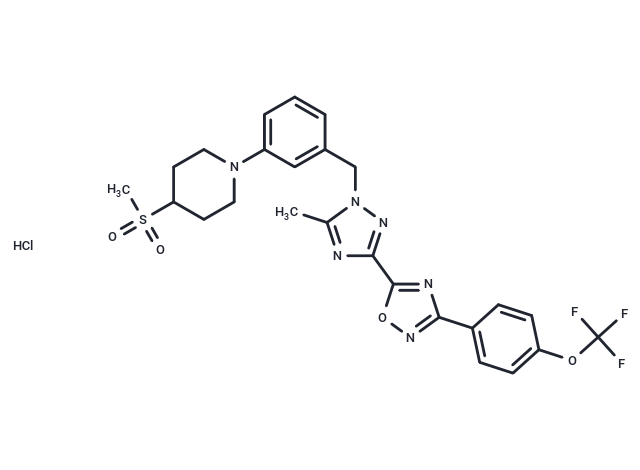Shopping Cart
Remove All Your shopping cart is currently empty
Your shopping cart is currently empty
IACS-010759 hydrochloride is an orally potent and selective OXPHOS inhibitor that inhibits proliferation and induces apoptosis in OXPHOS-dependent brain cancer and acute myeloid leukaemia models for the study of relapsed/refractory AML and advanced solid tumours.

| Pack Size | Price | USA Warehouse | Global Warehouse | Quantity |
|---|---|---|---|---|
| 1 mg | $48 | In Stock | In Stock | |
| 5 mg | $122 | In Stock | In Stock | |
| 10 mg | $178 | In Stock | In Stock | |
| 25 mg | $297 | In Stock | In Stock | |
| 50 mg | $439 | In Stock | In Stock | |
| 100 mg | $648 | - | In Stock | |
| 200 mg | $926 | - | In Stock | |
| 1 mL x 10 mM (in DMSO) | $162 | In Stock | In Stock |
| Description | IACS-010759 hydrochloride is an orally potent and selective OXPHOS inhibitor that inhibits proliferation and induces apoptosis in OXPHOS-dependent brain cancer and acute myeloid leukaemia models for the study of relapsed/refractory AML and advanced solid tumours. |
| Targets&IC50 | Mitochondrial oxidative phosphorylation (Rat primary cells):12.2 nM, Mitochondrial oxidative phosphorylation (H460 cells):1.4 nM (72 h), Mitochondrial oxidative phosphorylation (Mouse primary cells):5.6 nM, Mitochondrial oxidative phosphorylation (Cynomolgus monkey primary cells):8.7 nM, Mitochondrial oxidative phosphorylation (AML patient-derived cells):10-100 nM (4-5 days) |
| In vitro | IACS-010759 hydrochloride shows potent in vitro activity by reducing AML cell viability and inducing apoptosis at concentrations of 10-100 nM over 4-5 days. It also inhibits mitochondrial OCR and oxidative phosphorylation-dependent viability in H460 cells, with an average IC₅₀ of 1.4 nM over 72 h. Similar potency was observed in cells from mice (IC₅₀ = 5.6 nM), rats (12.2 nM), and cynomolgus monkeys (8.7 nM)[1]. |
| In vivo | In NB-1 neuroblastoma xenograft mice, oral IACS-010759 hydrochloride at 5-10 mg/kg for 21 days significantly reduced tumor size, although 25 mg/kg was not well tolerated. In another model, daily or alternate-day dosing at 10 mg/kg for 35 days extended survival from 28 to over 60 days, and lower-frequency dosing (e.g., 2×/week) also improved outcomes. Pharmacokinetic studies showed that a 0.3 mg/kg dose had low clearance, limited distribution, and a prolonged half-life (>24 h)[1]. |
| Synonyms | IACS-10759 hydrochloride, IACS10759 hydrochloride, IACS-010759 HCl, IACS010759 HCl |
| Molecular Weight | 599.03 |
| Formula | C25H26ClF3N6O4S |
| Cas No. | 1807523-99-4 |
| Smiles | Cl.O=S(=O)(C)C1CCN(C2=CC=CC(=C2)CN3N=C(N=C3C)C4=NC(=NO4)C=5C=CC(OC(F)(F)F)=CC5)CC1 |
| Relative Density. | no data available |
| Color | White |
| Appearance | Solid |
| Storage | store at low temperature | Powder: -20°C for 3 years | In solvent: -80°C for 1 year | Shipping with blue ice/Shipping at ambient temperature. | ||||||||||||||||||||||||||||||
| Solubility Information | DMSO: 50 mg/mL (83.47 mM), Sonication is recommended. H2O: < 1 mg/mL (insoluble) | ||||||||||||||||||||||||||||||
| In Vivo Formulation | 2% DMSO+40% PEG300+5% Tween 80+53% Saline: 1 mg/mL (1.67 mM), Suspension. Please add the solvents sequentially, clarifying the solution as much as possible before adding the next one. Dissolve by heating and/or sonication if necessary. Working solution is recommended to be prepared and used immediately. The formulation provided above is for reference purposes only. In vivo formulations may vary and should be modified based on specific experimental conditions. | ||||||||||||||||||||||||||||||
Solution Preparation Table | |||||||||||||||||||||||||||||||
DMSO
| |||||||||||||||||||||||||||||||
| Size | Quantity | Unit Price | Amount | Operation |
|---|

Copyright © 2015-2025 TargetMol Chemicals Inc. All Rights Reserved.